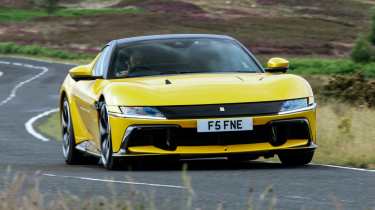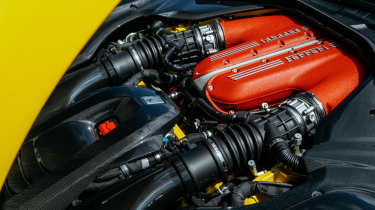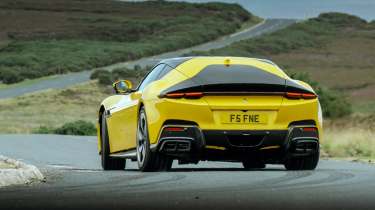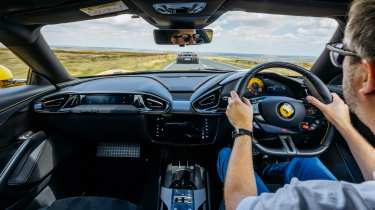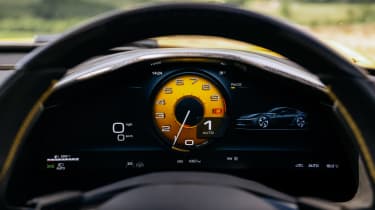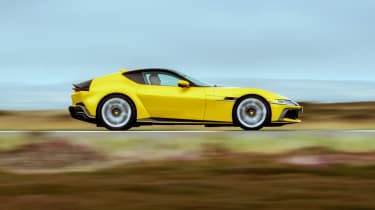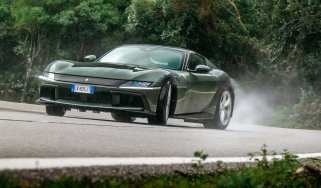Ferrari 12 Cilindri 2025 review – has the Aston Martin Vanquish rival gone too soft?
Ferrari describes its 819bhp, V12-powered 12 Cilindri as the most complete GT it’s ever made. We've put it to the test on the road in the UK
evo verdict
The 12 Cilindri’s bloodline goes back to the 550 Maranello, with the 599, F12 and 812 in between, so there’s some serious heritage to draw on. Those with wheel-time in its predecessors go a little wide-eyed at the memory, describing them as intense, dramatic cars. There’s less immediate drama and intensity here, but we're quite captivated by the 12 Cilindri.
The 12 Cilindri is an intriguing car with a unique personality, quite unlike any other current Ferrari, or any other GT car or front-engined supercar, in fact. It's a car that’s less extreme than its predecessors but arguably no less appealing. It wears its name well.
Engine, gearbox and technical highlights
- Development of the 812 Competizione’s V12
- Naturally-aspirated 819bhp - no hybrid tech here
- Active aero and four-wheel steering for stability
The 12 Cilindri is powered by a derivation of the 812 Competizione’s 6.5-litre, 65-degree V12 and still does without turbochargers and hybrid assistance yet develops 126bhp per litre. Peak power – reached at 9250rpm – is 819bhp, 30bhp more than the Superfast and identical to the Competizione. Here it’s augmented with an all-new exhaust system, and a new intake plenum with variable-length intake ducts. The oil pump system has also been redesigned and the fuel injection likewise.
More reviews
In third and fourth gear, the 12 Cilindri uses ‘Aspirated Torque Shaping’, whereby the torque curve is electronically controlled so that there’s a constant feeling of crescendo. Although 80 per cent of the maximum 500lb ft is available from as little as 2500rpm, the torque delivery is carefully tuned from 2000rpm all the way north of 7000rpm.
> Ferrari F80 2025 review – near-1200bhp tech tour de force tested on road and track
There’s also active aero. When longitudinal or lateral acceleration reaches a certain threshold, surfaces ahead of the rear lights deploy to an angle 10 degrees to the horizontal. They lift in unison, rather than individually à la Pagani Huayra. They’re capable of generating 50kg of downforce at 155mph and can shift the aerodynamic balance a little to the rear, aiding stability in fast cornering.
The 12 Cilindri uses Ferrari’s latest Side Slip Control software, in conjunction with a six-way chassis sensor system actively measuring and predicting the car’s movements and monitoring the slip of each individual wheel. You can still switch it all off but, as with other Ferraris, you’ll be quicker with it on. Stability is also aided by four-wheel steering. Unlike that of some other manufacturers, the rear wheels never turn the opposite way to the fronts; the system is used only to virtually lengthen the wheelbase at higher speeds.
Performance, ride and handling
- As quick as you’d expect given 819bhp
- Hyper-alert feel, if less so than the 812
- Playful chassis, but a relaxed grand tourer too
As with other modern Ferraris, the 12 Cilindri fires not from a button but a haptic touch surface, which robs a little tactility from the start-up ritual. Also in common with its recent siblings, the hyper-responsiveness of the steering and brakes takes a couple of miles to adapt to. You steer with your wrists rather than your arms and the brake-by-wire system is coupled with a short, sharp pedal action, too.
Despite its relatively large dimensions, the sense that this is a nimble car is immediate. But not only because of its hyper-sensitive controls; it’s inherent in the car itself. Weight distribution is around 48:52 front to rear, and there’s a sense of the car pivoting in the middle around you. The V12 sits behind the front axle line but the 12 Cilindri feels so wieldy you almost believe it could be sitting behind your shoulders.
On the road, the grip the Ferrari generates is remarkable. It’s a car you can really dig in with; it settles quickly in the first phase of a corner, and since the engine’s delivery is so linear you can get on the throttle early, leaning hard on the huge level of lateral grip. Yet despite all of that grip, it’s still a playful car. It responds like a lightweight mid-engined sports car rather than a large front-mid-engined GT car. You revel in the swiftness with which it responds as one, with zero slack.
The team behind the 12 Cilindri describe it as the most capable Ferrari gran turismo of all time, and its bandwidth is greater than that of its direct predecessors. It’s a refined car, one that covers ground with ease. The magneride ‘semi-active’ dampers have been designed to give less roll on track yet more comfort on the motorway, and the overall ride quality is excellent. On some of the UK’s bumpier surfaces it begins to feel a little busy, but almost never uncomfortable – the familiar bumpy road mode, on a press of the manettino, rounds off the edges of most bumps and gives the car a calm motorway gait too.
On track, the 12 Cilindri is not edgy in the way it relinquishes grip, and when it does slide, it regains balance swiftly. The F1 SuperSports we’ve tried, which took 18 months to develop, are not special track tyres; like the Michelins also available, they are designed to be good all-round performance tyres for road use, in keeping with the 12 Cilindri’s gran turismo remit. It’s not intended to be a track car but, for context, de Simone says it’s around 1 to 1.5 seconds a lap slower around Fiorano than a 296 GTB, but ‘way faster’ than an 812.
On the circuit’s long, wide straight there’s the chance to run all the way to the 9500rpm red line. The 12 Cilindri is still accelerating strongly at 180mph when we approach the braking point and back off. Top speed is quoted as ‘more than’ 211mph. The final drive is lower than the 812’s but top (eighth) gear is longer, the better for emissions. Gearshifts are 30 per cent faster and de Simone says Ferrari has worked to make downshifts feel more thrilling, with a more instantaneous response and sense of connection; it’s certainly hard to think of many cars that swap cogs faster, and each downchange from high revs is accompanied by a sharp induction bark.
Driver’s note
‘Hold onto the revs and the 12 Cilindri is wildly fast, though far quieter than the old 812 Superfast and perhaps a little less exciting (and intimidating) as a result. The less hyperactive feel does make it a friendlier road car though despite the enormous potential.’ – Antony Ingram, contributing writer, who drove the 12 Cilindri on UK roads
Interior and tech
- Dual-zone dash incorporates Ferrari’s latest tech
- Ergonomics aren’t perfect, but they’re not bad
- Firm seats don’t suit everyone
As with the Roma and Purosangue, the dashboard is split into dual ‘zones’ for driver and passenger. The passenger gets their own screen, with revs, speed, media and so on. The driver sits behind a 15.6-inch digital instrument panel, while the central touchscreen – for nav, climate, media and so on – has been designed with the intention that when it’s switched off it blends into the rest of the dashboard. It’s the opposite approach to cars that sit their screens on standalone armatures, tablet-style.
Aside from the nose-lift control on the central touchscreen, most of the car’s functions are accessed from the steering wheel. On the downside, the wheel still has haptic touchpads on its spokes like other modern Ferraris. On the upside, they now have indents to make it easier to find the control you’re after without taking your eyes off the road, and Apple CarPlay and Android Auto are more neatly integrated than ever so there’s little reason to recourse to Ferrari’s own, fiddlier interfaces.
The seats are more of a mixed bag. Some of us feel like the wrong shape, the seats not quite providing the shoulder and upper back support, and the wheel being a bit of a stretch away when the base is correctly positioned. They’re certainly firm for a car that’s now supposedly more of a GT, though if you’re the right shape, long-distance comfort is still excellent. Low-speed manoeuvring isn’t helped by the large turning circle and enormous blind spots; the (excellent) camera system is essential for parking.
Price and rivals
Both fixed-roof berlinetta and convertible 12 Cilindri Spider have gone on sale concurrently, priced at £336,500 and £366,500 respectively; deliveries of the Spider started around six months after those of the closed car.
If finding suitable alternatives for regular everyday sports cars is becoming difficult these days, there are no such problems at this level of the market. The 12 Cilindri has been joined on the market, more or less concurrently, by the latest £350,000 Aston Martin Vanquish, which shoots for the same super-sports grand touring role with its front-mounted V12, and then the Lamborghini Revuelto.
The Lambo’s the odd one out, being mid-engined and hybrid-assisted, but its V12 alone is in the same ballpark as the Ferrari for power (814bhp), while e-motors augment the total output to 1001bhp. Surprisingly, it’s no less a grand tourer, being far more approachable and easier to live with than the Aventador ever was, and even riding well on tricky UK roads. Pricing starts at around £450,000.
Other high-performance GTs include the oft-forgotten McLaren GTS (£180k) and the Maserati GranTurismo Trofeo (around £160k), though neither of those approach the level of the V12 cars, on prestige, ability, or price. Ferrari does have its own V12 grand tourer alternative though - the £313,000 Purosangue, which even lets you take a few friends along thanks to its four-seat layout.
Ferrari 12 Cilindri specs
| Engine | V12, 6496cc |
|---|---|
| Power | 819bhp @ 9250rpm |
| Torque | 500lb ft @ 7250rpm |
| Weight | 1560kg (dry) |
| Tyres as tested | Michelin Pilot Sport S 5 |
| 0-62mph | 2.9sec |
| Top speed | 211mph+ |
| Basic price | £336,500 |
